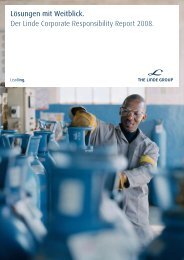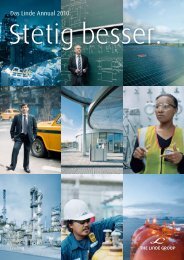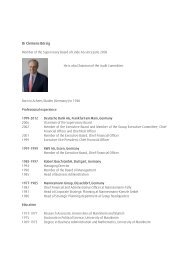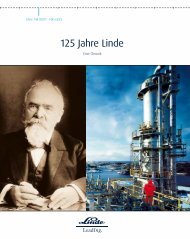The complete history of the development of The - The Linde Group
The complete history of the development of The - The Linde Group
The complete history of the development of The - The Linde Group
Create successful ePaper yourself
Turn your PDF publications into a flip-book with our unique Google optimized e-Paper software.
1898 1899<br />
First cathode ray luminescent screen tube by Karl Ferdinand Braun.<br />
Chemical company Bayer<br />
puts aspirin on <strong>the</strong> market.<br />
Of course <strong>the</strong> cooling in <strong>the</strong> 1,300 kilogram apparatus did not<br />
happen in one day. And during <strong>the</strong> night, some <strong>of</strong> <strong>the</strong> cold <strong>the</strong>y<br />
had obtained was lost again. But on <strong>the</strong> third day, May 29, 1895:<br />
“With clouds rising all around it, <strong>the</strong> pretty bluish liquid was<br />
poured into a large metal bucket. <strong>The</strong> hourly yield was about<br />
three liters. For <strong>the</strong> first time on such a scale air had been liquefied,<br />
and using tools <strong>of</strong> amazing simplicity compared to what<br />
had been used before,” said von <strong>Linde</strong>, still highly enthusiastic<br />
even 20 years after that day.<br />
Air liquefaction: just <strong>the</strong> beginning<br />
Air liquefaction was only <strong>the</strong> first step for von <strong>Linde</strong> towards a<br />
commercial viable use for his invention. His goal was to separate<br />
<strong>the</strong> liquid air, while re-evaporating it, into its constituents,<br />
since only <strong>the</strong>se, primarily oxygen and nitrogen, held promising<br />
industrial potential.<br />
First, however, he set about speeding up <strong>the</strong> long, drawnout<br />
process <strong>of</strong> cooling and liquefaction. To do this, he condensed<br />
<strong>the</strong> air to 200 atmospheres in <strong>the</strong> compressor and built <strong>the</strong><br />
countercurrent apparatus out <strong>of</strong> light, thin copper tubes.<br />
Air liquefiers for research<br />
<strong>The</strong> company soon delivered 72 small liquefaction plants to<br />
scientific institutions and used <strong>the</strong>m for public demonstrations.<br />
In Munich in 1898 at <strong>the</strong> “Second Engine and Industrial Machine<br />
Exhibition,” von <strong>Linde</strong> presented a small plant in <strong>the</strong> Diesel<br />
Pavilion driven by a 10 hp diesel engine – an impressive<br />
demonstration <strong>of</strong> <strong>the</strong> two greatest achievements <strong>of</strong> that time in<br />
<strong>the</strong> area <strong>of</strong> <strong>the</strong>rmal engineering. And at <strong>the</strong> 1900 Paris World’s<br />
Fair, <strong>Linde</strong>’s air liquefaction plant received <strong>the</strong> Grand Prix, <strong>the</strong><br />
most coveted prize <strong>of</strong> <strong>the</strong> exhibition. <strong>The</strong>se public demonstrations<br />
– even Kaiser Wilhelm II came to see it in Berlin – were<br />
possible because, with <strong>the</strong> new design, he had reduced <strong>the</strong><br />
N o 0087Device for <strong>the</strong> recovery <strong>of</strong> refrigerant<br />
lost from <strong>the</strong> suction line <strong>of</strong> a refrigeration machine.<br />
chilling time until liquefaction from 15 hours originally to just<br />
one hour. Fur<strong>the</strong>r improvements later reduced <strong>the</strong> process to<br />
just 15 minutes.<br />
Years <strong>of</strong> patience<br />
A commercially viable method <strong>of</strong> separating oxygen out <strong>of</strong> liquid<br />
air would, however, take some time. Von <strong>Linde</strong> made his first<br />
attempts with “fractionation”: Since oxygen boils at minus 183<br />
degrees Celsius, and nitrogen at minus 196 degrees Celsius,<br />
when liquid air is heated, nitrogen evaporates 13 degrees Celsius<br />
sooner than oxygen and can be separated – “fractionated” –<br />
from <strong>the</strong> rest <strong>of</strong> <strong>the</strong> gas mixture.<br />
However, because <strong>the</strong> temperature difference was so slight, not<br />
all <strong>of</strong> <strong>the</strong> nitrogen was released using <strong>the</strong> fractionation method.<br />
In fact a considerable portion remained in <strong>the</strong> subsequently<br />
evaporating oxygen. Only a 50-50 mixture could be economically<br />
produced in this way – <strong>the</strong> “<strong>Linde</strong> Air.”<br />
<strong>Linde</strong> air liquefaction plant at <strong>the</strong> Paris World’s Fair in 1900.<br />
25



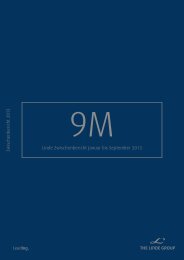
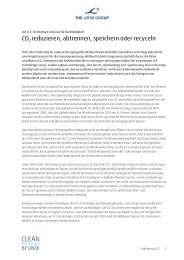

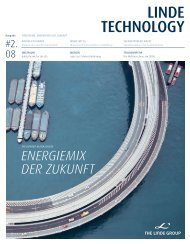
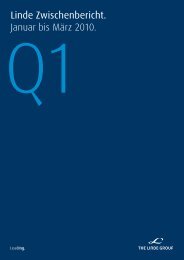
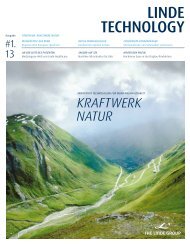
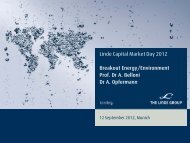
![[41] Anteilsbesitzliste des Linde Konzerns und ... - The Linde Group](https://img.yumpu.com/8356102/1/184x260/41-anteilsbesitzliste-des-linde-konzerns-und-the-linde-group.jpg?quality=85)
![[41] Anteilsbesitzliste des Linde Konzerns und ... - The Linde Group](https://img.yumpu.com/8356076/1/184x260/41-anteilsbesitzliste-des-linde-konzerns-und-the-linde-group.jpg?quality=85)
